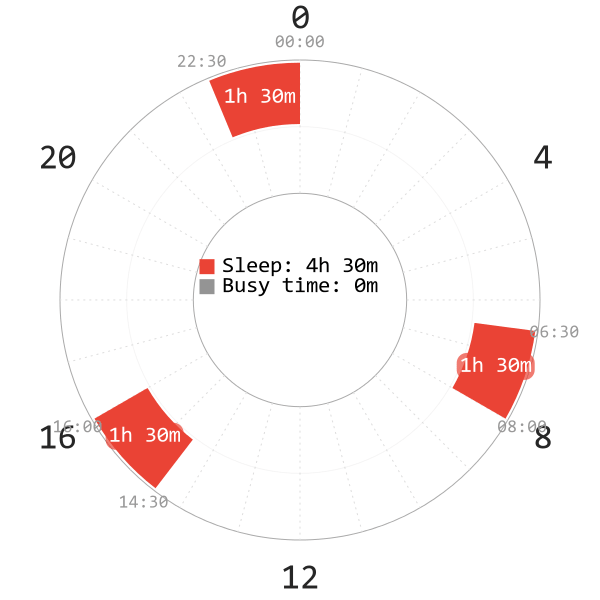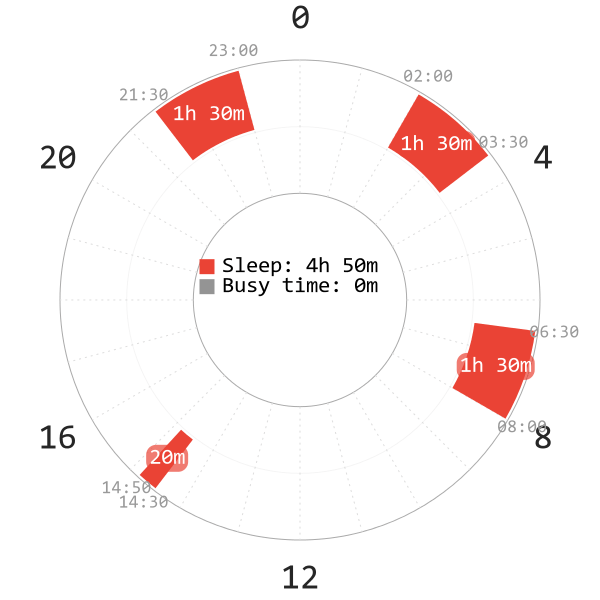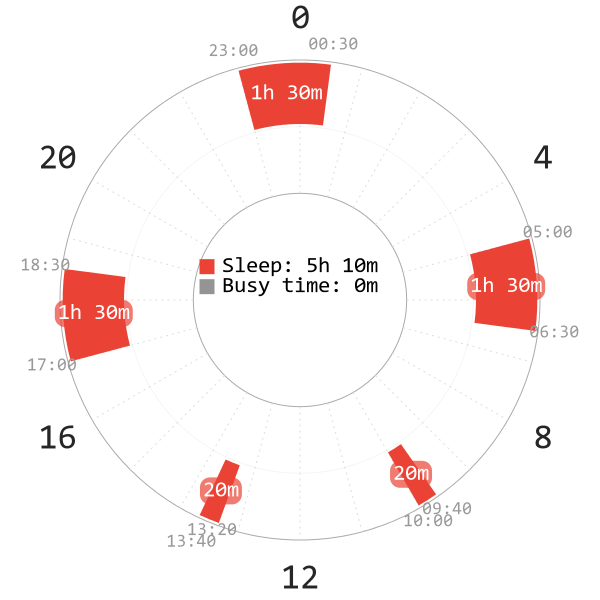TRI CORE
The Tri Core family of sleep schedules are relatively unusual and not very popular. This is due to hard scheduling of sleep along with wake time activities. The schedules in this group have an SWS-focused core, a REM-focused core, and a mixed core. All these cores only have a single cycle. The number of naps is also very low compared to other schedules (between 0 and 2).
A perk of these schedules is that a good amount of multiple types of sleep distribute across the day.
- This division of sleep aids in sustaining wakefulness and minimizing homeostatic pressure.
- The short single-cycle sleep blocks can help promote greater levels of sleep compression; this may help with raising the sleep quality drastically. Otherwise, this would only be seen on schedules with much smaller sleep quantities like Everyman 4/5, Dual Core 3/4 or nap-only schedules.
Triphasic (4 hrs 30 mins)
- Invented by: Leif Weaver.
- Alternatively known as: Tri Core 0, TC0.
- Total sleep: 4 hours 30 minutes.
- Classification: Tri Core schedule.
- Specification: 3 cores of minimum length.
- Mechanism: One core sleep before midnight, one around dawn, and one around noon. SWS and REM go into 2 night cores, like Dual Core sleep. Lastly, there is a long siesta to balance out the schedule.
- Adaptation difficulty: Hard.
- Ideal scheduling: One core sleep around 21:00, one around 05:30, one around noon.
Tri Core 1 (4 hrs 50 minutes)
- Invented by: The Polyphasic Discord Community
- Total sleep: 4 hours 50 minutes
- Classification: Tri Core schedule
- Specification: 3 core sleeps of minimum length, 1 nap
- Mechanism: Sleep stage division: 1 SWS core, 2 REM core and 1 REM nap. 3-hour rhythm to line up with sleep-wake cycle length of each core sleep.
- Adaptation difficulty: Hard
- Ideal scheduling: 3 core sleeps are during the night to boost alertness for the whole day, so only one small nap in the afternoon is necessary. There should be a 3-hour rhythm among each core sleep. Distance of wake time among each core sleep could shorten if possible, but should not be less than 2 hours. Such a schedule will include a dusk core, night core, and dawn core.
Tri Core 2 (5 hrs 10 minutes)
- Invented by: LichterLoh
- Total sleep: 5 hours 10 minutes
- Classification: Tri Core schedule
- Specification: 3 core sleeps of minimum length, 2 naps
- Mechanism: Sleep stage division: 1 SWS core, 2 REM core and 2 REM naps
- Adaptation difficulty: Hard
- Ideal scheduling: Evening core, graveyard core, dawn core and 2 daytime naps.
Comparison between Tri Core schedules
NOTE:
- The assessment table showcases differences between Tri Core schedules, based on standard scheduling.
- Unless specified otherwise, there are no mentions on extended versions.
- The table does not account for short sleepers; thus, these criteria will likely vary in them.
- Assessment denotations:
- 4/4: Positive, very high viability, or very easy
- 3/4: Somewhat decent viability, above average, or somewhat easy
- 2/4: Neutral, medium viability
- 1/4: Overall negative, low viability, below average, or difficult
| Criteria | Triphasic | TC1 | TC2 |
| Exercising |
| ||
| Time zone travel (> 5h) | |||
| Evening social time (18:00-23:00) |
| ||
| Daytime napping (7:30-17:00) | |||
| Schedule nap around meal time | |||
| Overall flexibility | |||
| Flexible core(s) |
| ||
| Hidden potential(s) | ~9-10h morning wake gap | None | None |
| Criteria | Triphasic | TC1………. |
| Exercising |
| |
| Time zone travel (> 5h) | ||
| Evening social time (18:00-23:00) |
| |
| Daytime napping (7:30-17:00) | ||
| Schedule nap around meal time | ||
| Overall flexibility | ||
| Flexible core(s) |
| |
| Hidden potential(s) | ~9-10h morning wake gap | None |
| Criteria | TC2………. |
| Exercising | |
| Time zone travel (> 5h) | |
| Evening social time (18:00-23:00) | |
| Daytime napping (7:30-17:00) | |
| Schedule nap around meal time | |
| Overall flexibility | |
| Flexible core(s) | |
| Hidden potential(s) | None |
Brief analysis
- The only viable extended schedule in the TC family is Triphasic-extended. The convenience of sleeping only 3 times a day puts Triphasic-extended above other variants from TC1 and TC2.
- Triphasic-extended has shown the capability of having a 9-10h morning wake period (the 90m daytime core is after work/school). It is the only scheduling variant in the TC family capable of doing so.
- To schedule TC variants, for the most part there has to be a core during SWS peak; this in return severely limits evening social time. However, Triphasic-extended can start this core at later hours, like 23:00 because of more total sleep.
- TC1 has only 1 short daytime nap, which is a huge bonus for long-term sustainability of the schedule. TC2 has many inconvenient daytime sleep blocks, while Triphasic’s 90m daytime sleep is what makes it unpopular.
- Triphasic and TC2 are the TC schedules that have a long wake period at night, similar to most Dual Core schedules. The core distribution of TC1 makes it resemble an “interrupted” monophasic sleep schedule, except with intentional wake periods to separate the segments clearly.
- Similar to Triphasic, TC2 also utilizes a daytime core for after school/work hours; this would give a longer rest after a long day.
- Because of the low number of naps, scheduling meals on TC schedules is mostly easy (bar TC2 with many sleep blocks around the clock).
- TC schedules may favor individuals with a tendency for longer sleeps than short naps.
- All TC schedules suffer from the usually low core flexibility. This is largely because flexing a core sleep is harder than a nap.
Comparison between Dual Core & Tri Core schedules
See Dual Core page.
Main author: Crimson & GeneralNguyen
Page last updated: 3 April 2021











